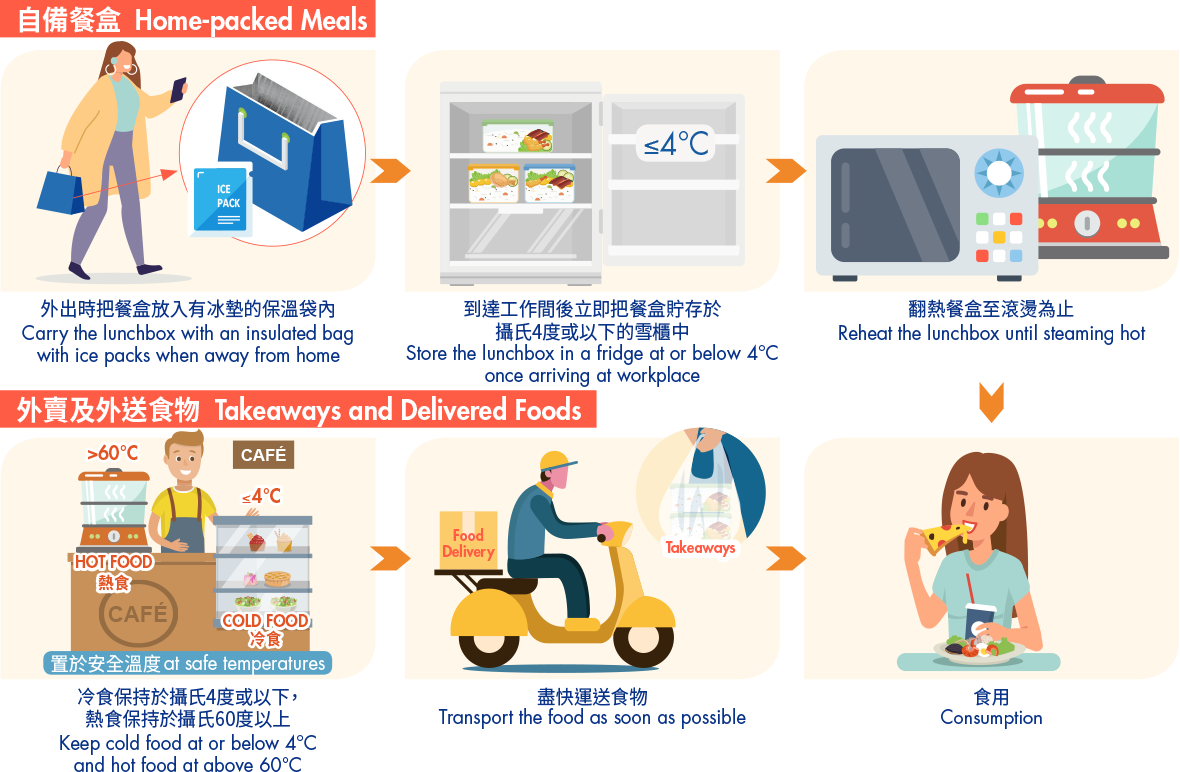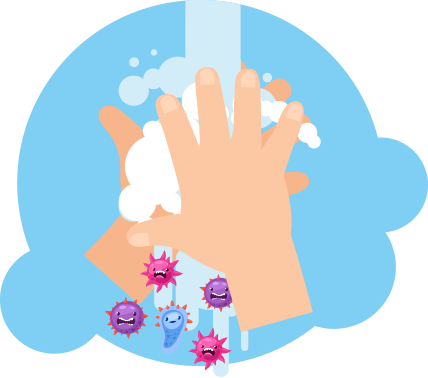
Food Safety Focus (165th Issue, April 2020) – Incident in Focus
Eat Safe: Home-packed Meals, Takeaways and Delivered Foods
Reported by Ms. Iris CHEUNG, Scientific Officer,
Risk Communication Section, Centre for Food Safety
Background
Due to the COVID-19 pandemic, people preferentially opt to pack their own meals or order takeaways and delivered foods from restaurants. Regardless of where the food is prepared, it is important to handle the food properly to keep it safe. The following will cover major food safety risks of packed meals prepared at home and by restaurant and provide tips to minimise the risk of foodborne diseases.
Food Safety Risks of Packed Meals Prepared at Home and by Restaurants
Home-packed meals, takeaways and delivered foods are in common that they are often not eaten instantly after preparation. They will be either stored or transported for some time before being served. During these steps, foods may be contaminated, and disease-causing bacteria present in these foods may grow to an unsafe level or produce heat-stable toxins if they are not kept properly, which will subsequently cause illnesses.
People usually prepare their own lunchboxes with foods that have been previously cooked and cooled. Excessive time for cooling may favour the introduction and growth of microorganisms in the foods. While re-heating can effectively kill microorganisms, it cannot eliminate the heat-stable toxins produced by the disease-causing bacteria, which could lead to food poisoning.
Figure 1. Safe handling of home-packed meals, takeaways and delivered foods.
Tips of Safe Food Handling
(A) Home-packed Meal
If you wish to keep some cooked food for consumption in your meal box the next day, plan ahead – pack just the right amount to be eaten before dishes are being shared among your family. Cool the food rapidly and keep it refrigerated until time to leave home. To maintain the cold temperature of your packed food as far as possible when away from home, carry it in an insulated bag, with ice packs if possible, and store it in a fridge at or below 4°C once arriving at your workplace.
Microwave ovens or food steamers are usually used to reheat lunches in offices. Make sure the food is thoroughly reheated until steaming hot. It is a good practice to stir the food about halfway through to facilitate even heat distribution. If a food thermometer is available, check the core temperature of the food and should reach at least 75°C. If reheating appliances are not available at your workplace, cook the food freshly in the morning or reheat the cooled food thoroughly at home before being stored in a vacuum flask. Reheated leftovers are not recommended to be cooled and stored again for later consumption.
(B) Takeaway and Delivered Meal
If you order a takeaway or delivered meal from a restaurant, consume it as soon as possible as the food may have been at room temperature for some time. As for the catering industry, more and more restaurants are switching their operation mode from made-to-order to preparing batches of food in advance to cater for the increasing demands for takeaway or food delivery orders. Of note, temperatures between 4°C and 60°C, also known as the temperature danger zone, favour the growth of microorganisms. To reduce the risk of food poisoning, restaurants should maintain the food out of the temperature danger zone before packing it for takeaway or delivery. Also, they should not prepare the food way too in advance.
Once the food is picked up by consumers or delivery persons, it should be transported as soon as possible if temperature control is not in place. As a rule of thumb, should the prepared food be kept at room temperature for less than two hours, it can be refrigerated for final use later or consumed within four hours. However, the food must be discarded if left at room temperature for more than four hours.

Figure 2. Wash hands to remove germs.
Frequently Wash Your Hands
Maintaining good personal hygiene is also vital to minimising the risk of acquiring germs. Sometimes we may eat with our hands, which is one of the sources of cross-contamination. Always keep our hands clean by washing with liquid soap and water, and rub for at least 20 seconds. When hands are not visibly soiled, alcohol-based handrub is an effective alternative.
Key Points to Note
- Home-packed meals, takeaways and delivered foods not intended for consumption instantly after preparation may pose a higher risk of foodborne illnesses if not being handled properly.
- If cooked food is to be cooled for later consumption, cool it rapidly and maintain the cold temperature during storage. Thorough re-heating is required before consumption.
- Keep food out of the temperature danger zone (i.e. 4°C to 60°C) to limit the growth of microorganisms, otherwise the two-hour and four-hour principle should be applied.
Advice to the Public
- When preparing lunchbox for the next day, pack the amount of cooked food to be eaten after cooking and cool it rapidly. Maintain the cold chain as far as possible (e.g. stored in the fridge, transport with an insulated bag and ice packs).
- Consume takeaways and delivered foods as soon as possible.
- Dirty hands can transmit germs and contaminate the food during preparation. Always keep your hands clean and maintain good personal hygiene.
Advice to the Trade
- Avoid preparing the food too far in advance of service. Keep hot food hot and cold food cold (i.e. above 60°C and at or below 4°C respectively).
- Shorten the time the delivered food left out of temperature control. Remind customers to consume the food as soon as possible where appropriate.
- Adopt the Five Keys to Food Safety and implement the HACCP system or follow its principles to ensure food safety. Keep records and adhere to the time and temperature requirements.

